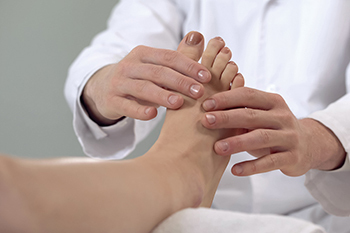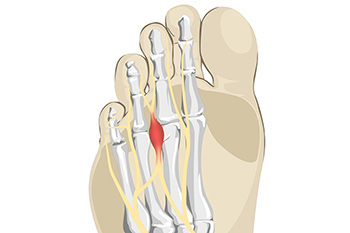Connect With Us
Blog
Items filtered by date: September 2022
What Do Cracked Heels Look Like

During the summer months when many people are concerned about how their feet look in sandals, you might hear talk about a foot condition known as cracked heels. This condition, also known as heel fissures, can occur as a result of dry weather and old age, among other causes. Cracked heels can look quite unsightly. Typically, an individual with this condition will exhibit deep cracks at the heel, with calluses surrounding the affected area that might also crack. In a case of heel fissures, the heel might even change colors, being slightly red. In some cases, a person with cracked heels might even see bleeding at the heel. Obviously, none of these visual symptoms are desirable. Prevent or cure cracked heels today by making an appointment with a podiatrist.
Cracked heels are unsightly and can cause further damage to your shoes and feet. If you have any concerns, contact Dr. David Ungar from Personal Foot Care. Our doctor can provide the care you need to keep you pain-free and on your feet.
Cracked Heels
Cracked heels appear unappealing and can make it harder for you walk around in sandals. Aside from looking unpleasant, cracked heels can also tear stockings, socks, and wear out your shoes. There are several methods to help restore a cracked heel and prevent further damage.
How Do You Get Them?
Dry skin is the number one culprit in creating cracked heels. Many athletes, walkers, joggers, and even swimmers suffer from cracked heels. Age and skin oil production play a role to getting cracked heels as well.
Promote Healing
Over the counter medicines can help, especially for those that need instant relief or who suffer from chronic dry feet.
Wear Socks – Wearing socks with medicated creams helps lock in moisture.
Moisturizers – Applying both day and night will help alleviate dryness which causes cracking.
Pumice Stones – These exfoliate and remove dead skin, which allows for smoother moisturizer application and better absorption into the skin.
Change in Diet
Eating healthy with a well-balanced diet will give the skin a fresh and radiant look. Your body responds to the kinds of food you ingest. Omega-3 fatty acids and zinc supplements can also revitalize skin tissue.
Most importantly, seek professional help if unsure how to proceed in treating cracked heels. A podiatrist will help you with any questions or information needed.
If you have any questions, please feel free to contact our office located in Farmington, MI . We offer the newest diagnostic and treatment technologies for all your foot care needs.
Broken Pinky Toe

A broken pinky toe is a fracture of the smallest toe. This can happen from a direct impact, stubbing the toe, or dropping something heavy on it. A broken pinky toe is a common fracture and the break often happens at the toe base. Symptoms of this type of fracture include pain, possible deformity, redness, bruising, and swelling. A snapping, grinding, or popping sound can also occur when a patient breaks their pinky toe, and fever may also develop. Though the discomfort from a broken pinky toe can cause unbearable pain at the time of a break, or when touched, it might not impact the ability to walk. If the toe is broken to the point of developing an open wound, immediate medical treatment must be sought to prevent infection. It is advised that you see a podiatrist if you have broken your pinky toe, and if it is left untreated, complications and chronic problems can arise.
Broken toes may cause a lot of pain and should be treated as soon as possible. If you have any concerns about your feet, contact Dr. David Ungar from Personal Foot Care. Our doctor will treat your foot and ankle needs.
What Is a Broken Toe?
A broken toe occurs when one or more of the toe bones of the foot are broken after an injury. Injuries such as stubbing your toe or dropping a heavy object on it may cause a toe fracture.
Symptoms of a Broken Toe
- Swelling
- Pain (with/without wearing shoes)
- Stiffness
- Nail Injury
Although the injured toe should be monitored daily, it is especially important to have a podiatrist look at your toe if you have severe symptoms. Some of these symptoms include worsening or new pain that is not relieved with medication, sores, redness, or open wounds near the toe.
If you have any questions, please feel free to contact our office located in Farmington, MI . We offer the newest diagnostic and treatment technologies for all your foot care needs.
Psoriatic Arthritis and Foot Conditions

Many individuals that suffer from psoriatic arthritis can develop three different kinds of common foot afflictions. Sometimes, before a diagnosis of psoriatic arthritis, an individual might even notice the onset of one of the following conditions. First, those with psoriatic arthritis can develop plantar fasciitis. This affliction occurs when the long band of tissue that runs along the arch of your foot (the plantar fascia) becomes strained and inflamed. This affliction is a common source of heel pain, particularly first thing in the morning. Second, those with psoriatic arthritis commonly develop Achilles tendonitis, which occurs when the tendon that runs between the heel and the calf muscle becomes inflamed. Heel pain is a typical symptom of this condition. Third, individuals living with psoriatic arthritis can commonly develop dactylitis, which can occur when a person’s toes become significantly and severely swollen. If you are living with psoriatic arthritis, take extra care of your feet. Leaving foot conditions like these unaddressed can create long term damage. Ensure that you are properly managing your psoriatic arthritis, and speak to a podiatrist. This foot specialist will be able to meet with you to assist you in maintaining the health of your feet.
Arthritis can be a difficult condition to live with. If you are seeking treatment, contact Dr. David Ungar from Personal Foot Care. Our doctor can provide the care you need to keep you pain-free and on your feet.
Arthritic Foot Care
Arthritis is a joint disorder that involves the inflammation of different joints in your body, such as those in your feet. Arthritis is often caused by a degenerative joint disease and causes mild to severe pain in all affected areas. In addition to this, swelling and stiffness in the affected joints can also be a common symptom of arthritis.
In many cases, wearing ill-fitting shoes can worsen the effects and pain of arthritis. Wearing shoes that have a lower heel and extra room can help your feet feel more comfortable. In cases of rheumatoid arthritis, the arch in your foot may become problematic. Buying shoes with proper arch support that contour to your feet can help immensely.
Alleviating Arthritic Pain
- Exercises that stretch the foot can prevent further pain and injury and increase mobility
- Most of the pain can be alleviated with anti-inflammatory drugs, heat, and topical medications
- Massages can help temporarily alleviate pain.
It is best to see your doctor for the treatment that is right for your needs and symptoms. Conditions vary, and a podiatrist can help you determine the right method of care for your feet.
If you have any questions, please feel free to contact our office located in Farmington, MI . We offer the newest diagnostic tools and technology to treat your foot and ankle needs.
Are Bunions Affecting Your Everyday Life?
What Is Morton's Neuroma?

Morton’s neuroma is a benign, but painful, condition that affects the ball of the foot. It occurs when the tissue around a nerve leading to a toe thickens from irritation or compression. It usually happens between the third and fourth toes, but can also happen between the second and third toes. If any symptoms are felt, the most prevalent is intermittent pain. There may be a burning sensation in the ball of the foot and a feeling like one is standing on a pebble, marble, or bunched up sock. The toes may feel tingly or numb, and one might have difficulty walking. Even though it feels swollen, there is no visible swelling on the foot. Morton’s neuroma is generally caused by wearing shoes that are too tight or have high heels, foot or gait abnormalities, participating in repetitive sporting activities, or an injury to the foot. If you experience pain in your feet, it is suggested that you see a podiatrist for a proper diagnosis and treatment plan. If not treated in a timely manner, this condition can cause permanent nerve damage.
Morton’s neuroma is a very uncomfortable condition to live with. If you think you have Morton’s neuroma, contact Dr. David Ungar of Personal Foot Care. Our doctor will attend to all of your foot care needs and answer any of your related questions.
Morton’s Neuroma
Morton's neuroma is a painful foot condition that commonly affects the areas between the second and third or third and fourth toe, although other areas of the foot are also susceptible. Morton’s neuroma is caused by an inflamed nerve in the foot that is being squeezed and aggravated by surrounding bones.
What Increases the Chances of Having Morton’s Neuroma?
- Ill-fitting high heels or shoes that add pressure to the toe or foot
- Jogging, running or any sport that involves constant impact to the foot
- Flat feet, bunions, and any other foot deformities
Morton’s neuroma is a very treatable condition. Orthotics and shoe inserts can often be used to alleviate the pain on the forefront of the feet. In more severe cases, corticosteroids can also be prescribed. In order to figure out the best treatment for your neuroma, it’s recommended to seek the care of a podiatrist who can diagnose your condition and provide different treatment options.
If you have any questions, please feel free to contact our office located in Farmington, MI . We offer the newest diagnostic and treatment technologies for all your foot care needs.


